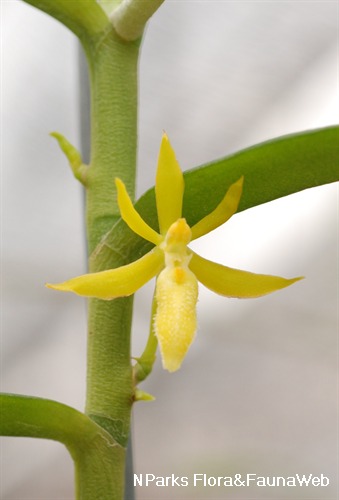
Name
Classifications and Characteristics
| Plant Division | Angiosperms (Flowering Seed Plants) (Monocotyledon) |
|---|---|
| Plant Growth Form | Epiphyte |
| Lifespan (in Singapore) | Perennial |
| Mode of Nutrition | Autotrophic |
Biogeography
| Native Distribution | Philippines |
|---|---|
| Native Habitat | Terrestrial |
| Local Conservation Status | Non-native (Horticultural / Cultivated Only) |
Description and Ethnobotany
| Growth Form | An epiphytic orchid, it has a pendulous growth form and can grow up to 100cm in length. |
|---|---|
| Foliage | The leaves are linear in shape in turn purple under strong sunlight. |
| Stems | The stems are thin and branch frequently, reaching up to 100cm in length. |
| Flowers | The flowers are borne in short inflorescences, each bearing up to 6 flowers opposite the leaf on a stem. The flowers measure about 10 to 12mm long and have pink-purple to pale pink sepals and petals. The flower lip is 3-lobed. |
| Habitat | It can be found in coastal forests and can occur up to 1000m in altitude. |
| Cultivation | It is best grown mounted on fern bark to accommodate its pendulous growth habit. It is ideally grown under light shade, in cool temperatures. |
Landscaping Features
| Desirable Plant Features | Ornamental Flowers, Ornamental Form |
|---|---|
| Landscape Uses | Parks & Gardens |
Plant Care and Propagation
| Light Preference | Semi-Shade |
|---|---|
| Water Preference | Moderate Water |
| Rootzone Tolerance | Low Humidity / Aircon |
| Propagation Method | Seed |
Floral (Angiosperm)
| Flower & Plant Sexuality | Bisexual Flowers |
| Flower Colour(s) | Pink, Purple, White |
|---|---|
| Flower Grouping | Cluster / Inflorescence |
| Flower Location | Axillary |
| Flower Symmetry | Bilateral |
Image Repository
Others
| Master ID | 31756 |
|---|---|
| Species ID | 6155 |
| Flora Disclaimer | The information in this website has been compiled from reliable sources, such as reference works on medicinal plants. It is not a substitute for medical advice or treatment and NParks does not purport to provide any medical advice. Readers should always consult his/her physician before using or consuming a plant for medicinal purposes. |



